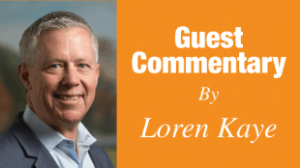 For much of our history, California was the land of opportunity because we were opportunistic. Whether by luck, agility or careful planning, we leveraged transformational events to our advantage.
For much of our history, California was the land of opportunity because we were opportunistic. Whether by luck, agility or careful planning, we leveraged transformational events to our advantage.
California grew as migrants arrived from the Depression-era Dust Bowl, and immigrants from upheavals in Latin America and Asia, initially providing the tough labor for an astonishing agricultural cornucopia. After World War II, when California was a keystone in the arsenal for democracy, demobilized veterans and more domestic and international immigrants arrived in the state, becoming the backbone of the subsequent success of one innovation after another in aircraft, spaceflight, computers, high technology, biotechnology, entertainment and cuisine—each spawning entire new industries—born in California.
Another globally transformational event arrived on our shores in the winter of 2020. California’s residents and institutions have suffered at least as deeply as anywhere on earth from the COVID-19 pandemic. Illness and death have reached every community, with the Los Angeles region hit especially hard. Economically, the worst off have been hospitality, tourism and other public facing businesses. Low wage and often low-skilled workers in these industries, along with small business owners statewide, have been devastated. These jobs and businesses will not reappear until commerce is again healthy, which requires the economy to reopen and customers comfortable to patronize them.
The pandemic will eventually fade. But even as our society recovers and reacquires what was normal, the crisis is reshaping the state, accelerating trends and widening uncertainty. 2020 was a year of crisis. Will 2021 be a year of opportunity? The great challenge to state leaders will be how to respond.
First, stop taking California’s success for granted.
Elected leaders often legislate as if California’s economic and demographic growth are disconnected from public policy.
Success has many parents. Our policy inheritance includes a clear-eyed embrace of prosperity and opportunity for much of the last century, meeting the moment with investments in world class systems of higher education, a transportation network, water development and distribution, and international ports and airports. These investments knit the state together and connected us to the world. Policy makers and the courts also entrenched a legal infrastructure that fostered competition in employment relationships, which ensured fluid access to skilled workers who could advance their own careers and seed the success of thousands of innovative firms.
More recently, this multi-generational success has led policy makers to treat California as a “luxury good.” They act as if residents are willing to pay a premium to live here. This attitude has given rise to expensive and divisive policy initiatives that serve political constituencies and cultural trends, but that do not register with residents and taxpayers.
If ever California was a luxury good, we’ve long since priced ourselves out of the market.
Our residents and tax base are voting with their feet.
Family moves to other states have accelerated each year for the past four years, while international immigration has slowed each of the past four years. Population growth has almost leveled off, adding residents at a rate unseen since the turn of the 20th century.
Sunbelt states are welcoming middle class and working Californians at an increasing pace, offering affordable homes, lower taxes and more value for their earned income. More recently, even some of the most venerable names from California’s high technology sector, which had endured higher costs because of the benefits of the industry’s workforce cluster, has joined the flight of ex-Californians leaving the state for lower taxes and less regulation.
California’s businesses and residents alike seem no longer willing to pay the “luxury tax” that policy makers have imposed for the privilege of living and working here. The cost of living and the cost of doing business have created a ceiling on growth and opportunity. California is no longer the only state that can offer opportunity for business success and individual fulfillment.
A recent CalChamber poll found that 54% of voters (27% strongly) agreed that “their family would have a better future if they left California.” Of those agreeing with this statement, two-thirds cited “cost of living” or “cost of housing” as the main reason, while another three in ten cited, “California values are not my values.”
The path to success is becoming more competitive–and California is falling short.
Second, let opportunity be your guide.
The California luxury tax falls hardest and most unequally on poor and working Californians. We have among the highest utility rates, gasoline prices, housing and rental costs, consumer taxes and insurance premiums in the nation. Virtually every recent legislative or executive action ratchets up these costs. When seeking solutions, elected leaders should peer through the correct end of the telescope: reduce the day-to-day cost of living for working Californians instead of burdening them with the price of the latest hot public policy trend.
Economic opportunity and social justice begin with ensuring a quality education for children, but California falls far short. The proficiency gap between white and Asian American students on the one hand, and Black and Hispanic students (who account for 60 percent of enrollments) for fourth and eighth grade math and reading is four- or five-to-one. Only about one-fifth of students from low-income families meet or exceed proficiency for fourth or eighth grade math or reading. These achievement gaps are not only immoral and deeply embarrassing, they are an existential threat to California’s economy, since these children are the future workforce for small and large businesses that choose to remain here.
Public school students have lost considerable ground during the pandemic–state leaders should make accountability and empowerment central themes for a recovery by restarting state assessments to understand where and how to address opportunity gaps, better focus resources on most disadvantaged schools, rather than using funds raised for disadvantaged students on districtwide priorities, and empower students and parents to push back against institutional inertia by changing the power dynamic for students (and their parents) to increase their influence in the delivery of quality outcomes–and in particular for those students with the least power.
Lifetime economic success can be predicted by education attainment. High school graduates outperform dropouts. Even some postsecondary education will enhance earning, while a college degree is highly correlated with higher wages and lower unemployment. Policy makers make an investment in wealth creation when they invest in our colleges and universities.
Our preeminent research universities additionally drive regional and statewide prosperity, serving as hubs of innovation, talent magnets and economic engines. It is only a slight exaggeration to suggest that without these world-renown universities, California would be just another very nice tourist destination.
The biggest and most deeply unfair luxury tax on working Californians is the cost of housing. State leaders have spent the past decade nibbling at the edges of the housing crisis—when they weren’t making it worse with mandates and fees. The only route to more affordable housing at scale is to build more market rate housing—which in turn will open up more affordable housing as homeowners buy up and greater supply dampens price increases.
Elected officials must engage in an all-fronts supply side campaign to ease the cost of buying or renting shelter by capping local housing fees, reinstating tax increment financing for targeted economic development to help pay for local infrastructure and housing, reshaping state-local tax sharing to reduce disincentives to approve new housing, quashing any further attempts at rent control, reforming the California Environmental Quality Act (CEQA) to remove litigation cost premiums on new housing, and improving highway and transit capacity for new housing to ease the commute for homeowners unable to afford expensive coastal or urban housing.
The California private sector generates opportunity throughout the income spectrum, but without public policy changes that opportunity will remain locked away for many.
Third, set aside pre-pandemic business-as-usual.
The safest prediction for the future is that many of our workplace and lifestyle arrangements are in flux.
Employers fortunate enough to deploy their workforce from home suffered less and some even thrived during the pandemic. Many at-home workers were burdened with child care or student supervision challenges where schools were shuttered, but the severe unemployment crisis passed over millions of remote workers.
Many companies have indicated they may continue work-from-home arrangements, in some cases indefinitely. Nobody knows the scope and extent of these new workplace provisions, but the implications could be vast:
- High-skilled and well-paid employees may choose to relocate out-of-state to more desirable and less expensive locations, affecting the state and local tax base.
- Continued work-from-home will have major ramifications on transportation, reducing congestion on commute-impacted roads but increasing impacts in residential communities as workers stay closer to home.
- Fewer commutes may reduce demand and support for mass transit systems.
- Commercial ecosystems of office buildings and support services may undergo vastly different uses to accommodate new worksite arrangements. Public policies based on traditional work arrangements may become partially obsolete. After the gig economy created opportunities for millions of workers, the Legislature enacted punitive regulation, which in turn was rejected in large part by the voters. As California employers and workers continue to evolve their relationships to each other, the workplace and the community, the Legislature must evolve responsive policy, and not retard innovation to satisfy uncompetitive interests.For example, telecommuting has enabled working parents to support their distance-learning children while still maintaining a job. However, existing state laws do not provide the necessary flexibility for employers to accommodate the scheduling challenges parents are facing with working and supporting kids at home. Employers who allow employees to work separate shifts in a day, work more hours one day to take time off on another day, or even skip a break to finish working early, may be penalized and fined. The laws should be updated to address this disincentive so employees can enjoy the flexibility they need to meet these work and home demands.Other worker benefits oriented to the employer’s work site may need updating to recognize and even encourage employer interest in alternative workplace arrangements. Indeed, the profound societal benefits from less traffic congestion, fewer greenhouse gas emissions, and more time with family should make alternative time and place scheduling for employees a key response to the pandemic.
In the midst of our nation’s worst crisis, President Lincoln envisioned the possibilities, telling Congress, “The dogmas of the quiet past are inadequate to the stormy present…. As our case is new, so we must think anew and act anew.”
The dogmas of California public policy are luxuries we can no longer afford. The price has become too high—in thwarted opportunity for youth, fleeing businesses, the squeezing of the middle class, and weakening social cohesion.
The Governor and Legislature should turn the COVID-19 crisis into a great California disruptor: using our response to the pandemic as the catalyst to rescue California from itself.
Loren Kaye is president of the California Foundation for Commerce and Education.


